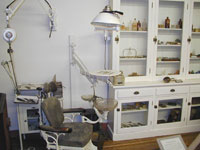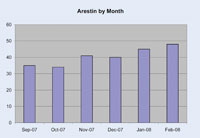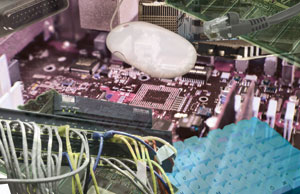Paperless dentistry, the storage, sorting, and retrieval of computerized dental records, has provided not just a step, but a leap forward in the efficiency and quality of patient care. However, we can continue to expand our uses of dental computers by adapting some additional easy, free, and powerful strategies to make our practices more profitable while providing superior treatment. This article discusses several simple computer strategies that any office can easily incorporate without changing practice management software. These strategies are user dependent, not software dependent. They will only require changing a few practice habits and are not a computer version of Extreme Makeover.
THE GOAL IS EFFICIENCY
 |
| Figure 1. Our operatories may appear more modern than this historical one seen in a museum display, but often our techniques for handling information remain antiquated, based on old-fashioned paper-based habits and dental myths. |
The goal of paperless dentistry has never been the elimination of paper from the dental office. Rather, the goal is to replace the use of paper as electronic media becomes more efficient, such as with the storage, sorting, and retrieval of information. With more modern technologies, we need to rethink the way we do things (Figure 1). Did you ever notice that really old sinks, like the one in G.V. Black’s 1908 operatory, had 2 separate spigots for the hot and cold water? People at that time were accustomed to washing in a pan of water. As a result, they ran hot and cold water separately into a sink with a stopper and then washed in the “pan.” It took awhile for people to realize that it was nicer to wash in a mixed stream of warm water from a single spigot. Now sinks with separate hot and cold spigots have pretty much gone the way of the amalgam squeeze cloth. Similarly, there are now much better computerized ways of doing things than the old paper-based ways we were forced to use in the past.
G.V. Black used to have a ledger tray where he stored his accounts receivables. He had to file the patient ledgers alphabetically because he could not find them any other way. Our habit of sorting everything solely by alphabet is an example of an inefficient holdover from our paper-based days. With computers, it is usually much better to sort by other measures, since the computer does all the work and can instantly sort all accounts by more useful criteria. However, some offices persist in printing accounts receivable reports alphabetically. Instead, these should be printed by oldest balance or largest balance first. This is a much more profitable way to work the accounts. Similarly, unscheduled treatment lists should be sorted by the value of the treatment plan, or by the types of procedures the doctor likes to perform, not by alphabet. Referral reports should not be sorted by the referring patient’s last name. Rather, they should be sorted by the number of people referred, or by the value of the treatment completed. G.V. Black had to sort alphabetically…we don’t! We can use more productive computer strategies.
The use of electronic insurance claim processing is an example where computers are much more productive than paper. It is no longer efficient to print and mail a paper claim when an electronic claim is cheaper, easier, and gets the payment into the dental office much more quickly. But in some cases, paper still has advantages as we transition to an all-electronic media. Most patients still appreciate appointment cards, printed of course by the computer appointment scheduler so there are no mistakes, when they leave the office. However, because 70% to 90% of our patients now have e-mail, all follow-up re-minders can be sent electronically and automatically. The system that we use (uappoint.com) invisibly links to our ap-pointment scheduler and sends reminders without our staff doing any work. Electronic claims and e-mail appointment confirmations provide economic benefits to the practice while benefiting patients by helping them keep their scheduled appointments.
PUTTING OUR “DIGITAL EMPLOYEES” TO WORK
In a modern office, it is more efficient and cost-effective to have our “digital employees” (our computers) do more of the work. We paid for those computers, but most of the time they just sit there idle! We would not put up with that from any other employee!
G.V. Black’s receptionist used to have patients address their own recall cards because she thought they responded better to a postcard in their own handwriting. (That’s probably how this dental myth began.) However, if the patient did not respond to the single postcard, that patient was often lost. These days, we should make those lazy computers send out a series of re-minders, either postcards or e-mails, automatically at 3 months, 6 months, and 12 months overdue. Little or no staff time is necessary, it maintains hygiene production, and helps to ensure better periodontal health for our patients. Once this computer-based recare system is established, it works forever without any further attention from the doctor.
We can also probably thank G. V. Black’s receptionist for starting another deeply ingrained dental myth: the need to “confirm” patient appointments by telephone. In G.V. Black’s day, telephones were novel, and it might have seemed like a good idea. However, in our busy group practice, when we stopped telephone confirmations, the number of missed appointments went down! Our computers carefully track missed appointments, and we graph the results so that we are not myth-based, but fact-based. We did not just suddenly stop telephone confirmations. We made a point of telling each patient we were discontinuing this behavior and asked them to “Please be sure you do not make an appointment that you are not sure you can keep, and be sure to keep each appointment that you make.” This worked like a charm! We do continue to do our automatic e-mail confirmations, and, for patients without e-mail, we send out a computer-generated postcard 2 weeks ahead of pre-booked recare appointments. Also, we never charge for missed appointments, but we do send out an automatically generated missed appointment letter asking the patient not to miss any more appointments. If the patient misses 3 appointments with 3 warning letters, which the computer tracks, we “fire” them. This also works like a charm. I can hear you thinking, “That won’t work in my practice!” Yes, it will, if you handle it properly. You would be surprised at the number of dentists in our seminars who confirm this. Computers help us become fact-based instead of myth-based. You can see more examples of myth versus fact on our Web site, paperlessdentistry.com.
GRAPHS, STAFF, AND THE HAWTHORNE EFFECT
 |
| Figure 2. Easily made graphs share information with staff to help promote desired changes by taking advantage of the Hawthorne Effect from industrial psychology. |
I mentioned making graphs to illustrate trends, such as failed appointments, that are sometimes difficult to see as just numbers. For G.V. Black, making a graph was time-consuming and difficult. For us, it is almost instant and very simple. With a spreadsheet program such as Microsoft Excel or OpenOffice Calc (a free program available at openoffice.com), you just click and drag the mouse to create an instant, colorful, and informative graph. Don’t be intimidated by the prospect of learning to use a spreadsheet; it is really very easy and intuitive to do the basics such as making a graph (Figure 2). Lots of helpful Web sites are available to help teach these techniques. You might also ask your staff members if one of them already knows how. I was quite surprised to learn that one of our hygienists already was very accomplished with using Excel. We now utilize her skills to help administer our practice.
Graphs let you productively exploit something that was unknown to G.V. Black, and is actually little known in dentistry even today. It is the observation from industrial psychology known as the Hawthorne Effect. The Hawthorne Effect predicts that people’s performance usually improves following any new or increased attention. We nagged our staff for 2 years to collect e-mail addresses when patients came into the office. The computers showed about 70% staff compliance. However, when we graphed compliance over time and shared this with staff members, their compliance improved to nearly 100% in about 2 months. We had a similar improvement with the collection of referral sources for new patients. We also started tracking the use of topical antibiotics in periodontal pockets and graphing this by hygienist. In addition, we now graph the number of porcelain veneers and implants we do each month because we want to increase these procedures in our practice. We graph the number of new patients each month, and the percentage of these patients that have appointments at the end of 3 months, so we know who didn’t just walk out the back door. It is still early, but all of these strategies have resulted in positive changes, and they take only minutes per month to accomplish. Remember, the computers do almost all the work. The Hawthorne Effect provides free practice enhancements with almost no time or effort. G.V. Black would be green with envy!
Staff bonuses, based on some combination of production and collections, are usually a good idea. They encourage staff participation, improve morale, and tie salary increases to actual office profitability. But often, I see two problems with them. First, they are frequently so complicated that they are labor-intensive to calculate, and this is often the dentist’s labor. Second, while staff members may be motivated by this month’s bonus, they sometimes forget just how much the bonus has contributed to their paychecks over the last year. Our computer strategies have eliminated both of these problems. Using a simple spreadsheet that our practice manager updates in 2 minutes at the end of each day, the month-to-date bonus for each person is calculated and updated for each staff person. This number is automatically linked to our morning meeting report so that everyone knows each morning exactly where they stand. Furthermore, because we use a computerized payroll program that can export all reports to a spreadsheet, we can instantly graph the percentage each employee’s bonus has contributed to his or her take-home pay for the year. Now, our computerized bonus program is simpler to administer and provides more motivation for our staff.
MOVING THE FRONT DESK TO CHAIRSIDE
 |
| Figure 3. The trend toward the “front deskless” office may not mean the elimination of the physical front desk, but rather the transfer of tasks to other areas such as the operatory, where they can be done quickly, easily, and more accurately. |
The idea of “front deskless” dentistry has probably been around almost as long as paperless dentistry, but it is now becoming more common (Figure 3). Again, the goal is not necessarily to eliminate the physical front desk from the office, but rather to reduce or redistribute the tasks that were formerly done at that front desk. Clinical charting, posting, treatment plan entry, insurance claim submission, lab slip generation, and of course appointment scheduling, are all much more efficient chairside. Our office is front deskless only in the sense that fewer people perform fewer tasks in that area.
Two other practices that I visited recently have gone much further. In one office, the doctor works with only 2 staff people, both clinical assistants. They process all patient transactions at chairside. All 3 people, including the doctor, wear wireless telephone headsets, and whoever is free to take the call answers the phone. While one assistant is with the doctor, the other takes care of administrative tasks such as account follow-up and supply ordering. They have a computer in their lab area, but the only thing on the front desk is a vase of flowers. In the other practice, there is not only no front desk, there are no human staff members. The doctor does everything by himself: all appointments, charting, treatment planning, collections, billing, etc. If the phone rings, and he cannot answer it, his answering machine takes the message, and he returns the call when he has time. His only employees are his computers. He admits this may not be the most efficient way to practice, but he really likes the fact that everything is in his direct control and he has no staff salaries, sick days, vacations, holidays, training, complaining, quarreling, or any other staff issues. These 2 practices may not represent ways that most of us would like to practice, but they show what is possible. For the rest of us, more practical strategies allow us to use our computer systems to expand our management capacity. We can do this all while reducing everyone’s work load and increasing profitability via the decentralization of tasks that previously could only be done at the front desk.
CONCLUSION
G.V. Black and his receptionist might have been wonderful and productive people, but they practiced 100 years ago. It behooves the modern dentist to dispense with the inefficient paper-based habits and myths of the past and embrace the advantages that computer-based strategies bring to our practices. Computerized scheduling, e-mail appointment cards, electronic insurance submission, replacing alphabetical sorting with more productive criteria, multiple recare reminders, eliminating counterproductive telephone appointment confirmations, using graphs to take advantage of the Hawthorne Effect, an effective staff bonus system, and decentralizing tasks away from the front desk to areas such as the operatory where they can be done more efficiently… these are just some of the ways computers allow us to move beyond paperless dentistry to gain more benefits for our staff, our patients, and for ourselves. Most importantly, these are easy to do and most of them are free.
Dr. Stephenson is the managing partner in the highly computerized, paperless, front deskless, wireless adult group practice that he founded in 1977. He bought his first dental computer in 1979 and has consulted, lectured, and written about dental computing since 1985. You can find useful information about dental computing, his seminar schedule, and other information at his Web site, PaperlessDentistry.com. He can be reached at Bruce@PaperlessDentistry.com.









